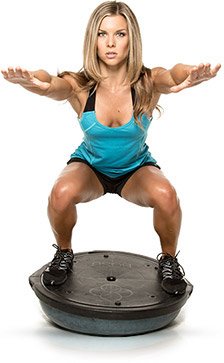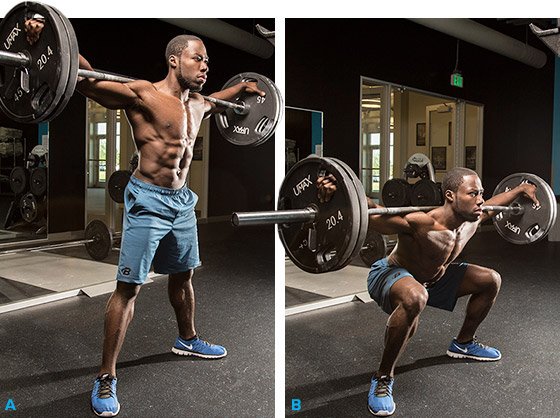Corrective exercise is a double-edged sword. On one hand, we all have weaknesses that could benefit from attention. Muscular imbalances, postural issues, and aberrant movement patterns can—and often do—lead to discomfort, pain, and in the worst-case scenarios, injury.
On the other hand, once a trainer sniffs the phrase "corrective exercise," athletes almost inevitably get this look in their eyes that says, "How about I do Tabata sprints all the way out to my car instead?"
I can't say I blame them. No one wants to spend 30 minutes activating their glutes—no one. And while having someone stand on a BOSU ball while shaking a body-blade in one hand and juggling oranges in the other may be some people's definition of corrective or, (excuse me while I throw up in my mouth) "functional," I'm pretty sure it's actually a waste of valuable training time.
Athletes don't want to feel like patients when working out. They want to train! And yet far too often, I've seen coaches and personal trainers take an overly cautious approach with clients, thereby failing to elicit the one thing that's most important: a training effect.
It's time for a new strategy, where you waste minimal time and get maximum transfer to your performance. Spread the word: Corrective exercise as you know it is dead!
WHAT CORRECTIVE EXERCISE SHOULDN'T BE

Sometimes, our role as a coach or trainer is to pull the reins a bit and help people get out of their own way. But this doesn't mean we need to begin acting like physical therapists—because we're not, and very few of us are qualified to pretend we are.
About 10-15 years ago, many coaches and trainers decided to take unstable surface training —a modality popularized in the physical therapy realm for injured people— and apply it toward healthy clients and athletes in a training setting. This is why, if you research "corrective exercise," you're bound to get a kazillion pictures of BOSU balls, stability balls, wobble boards, and other balance-training tools.
I don't want to turn this into a diatribe against training on an unstable surface, because there is a time and place for it. But when applied to—or inflicted upon—healthy individuals in the middle of a workout, all it does is decrease power output, promote faulty movement patterns, and suck energy away from more deserving activities.
So let's make this absolutely clear: Unless you have a very good reason to do unstable surface training, avoid it. It's not corrective, and it's not correct. If necessary, tell your trainer that Uncle Tony gave you a free pass.
GOOD TECHNIQUE THE ULTIMATE CORRECTIVE
If I had to summarize my point of view in five words, it would be this: Correct movement is corrective exercise!
If coaches and trainers took the time to properly coach their clients and athletes, rather than trying to impress them or make them feel "worked"—i.e., weak—I'm positive they'd see better results.
Likewise, if you take the time to learn how to perform certain movements correctly—which often involves regressing exercises to your current ability—you'll not only see marked improvements in your overall performance, but also how you look and feel.
Let's use the squat as an example. My first priority is cleaning up a person's technique and getting them doing things like:
- Sitting back with the hips
- Pushing their knees out
- Letting the knees move forward slightly
- Engaging the lats by pulling down on the bar
- Not overarching the back
- Finishing the movement with their glutes at the top

Barbell Squat
When you can follow those cues, or by fixing the problems I outlined in my article on common squat mistakes, the squat itself can have profound corrective effects. Yes, we may need to address things like limited ankle dorsiflexion or limited hip mobility, but more often than not, the biggest hurdles can be overcome by simply grooving proper technique. The same goes for rows, chins, deadlifts, Pallof presses, and pretty much all of the other movements I included in my 8-Week beginner plan for Bodybuilding.com.
WHERE THE BORING STUFF FITS
Yeah, about those ankles and hips... I do feel it's still important to sneak in some traditional corrective exercise, both to address universally problematic areas and for preventative maintenance.
Pretty much everyone has issues with poor glute activation, poor T-spine mobility, limited ankle dorsiflexion, short and tight hip flexors, and poor anterior core engagement. These are just part of living in a civilization that doesn't do as much as it used to. And yes, this applies to gym rats too.
For this reason, it's important to include a brief dynamic warm-up prior to each training session, which serves a few purposes:
- It helps improve movement quality.
- It mentally prepares you for your training session.
- When done consistently, it can have a surprising corrective effect over time.
We're only talking 5-10 minutes of your time here, and yet it can have a profound effect on your performance in the gym and how you feel overall. Here's one of my favorite one-size-fits-all "corrective" warm-ups.
Squat to Stand with Reach
Watch The Video - 00:07
If you're too stubborn to even do that, you can use what I like to call "fillers."
These are mobility drills, activation drills, and stretches that you strategically pair with certain exercises during rest periods. So rather than staring at the television or being Creepy McCreepypants and gazing at your secret crush across the gym floor, you can actually do something productive with your time.
Yoga Plex
Watch The Video - 00:13
The key is to use fillers that target areas you know need work, but which won't interfere with the main movement or inhibit performance in the subsequent sets. Remember, we're here to get strong, not feel weak!

